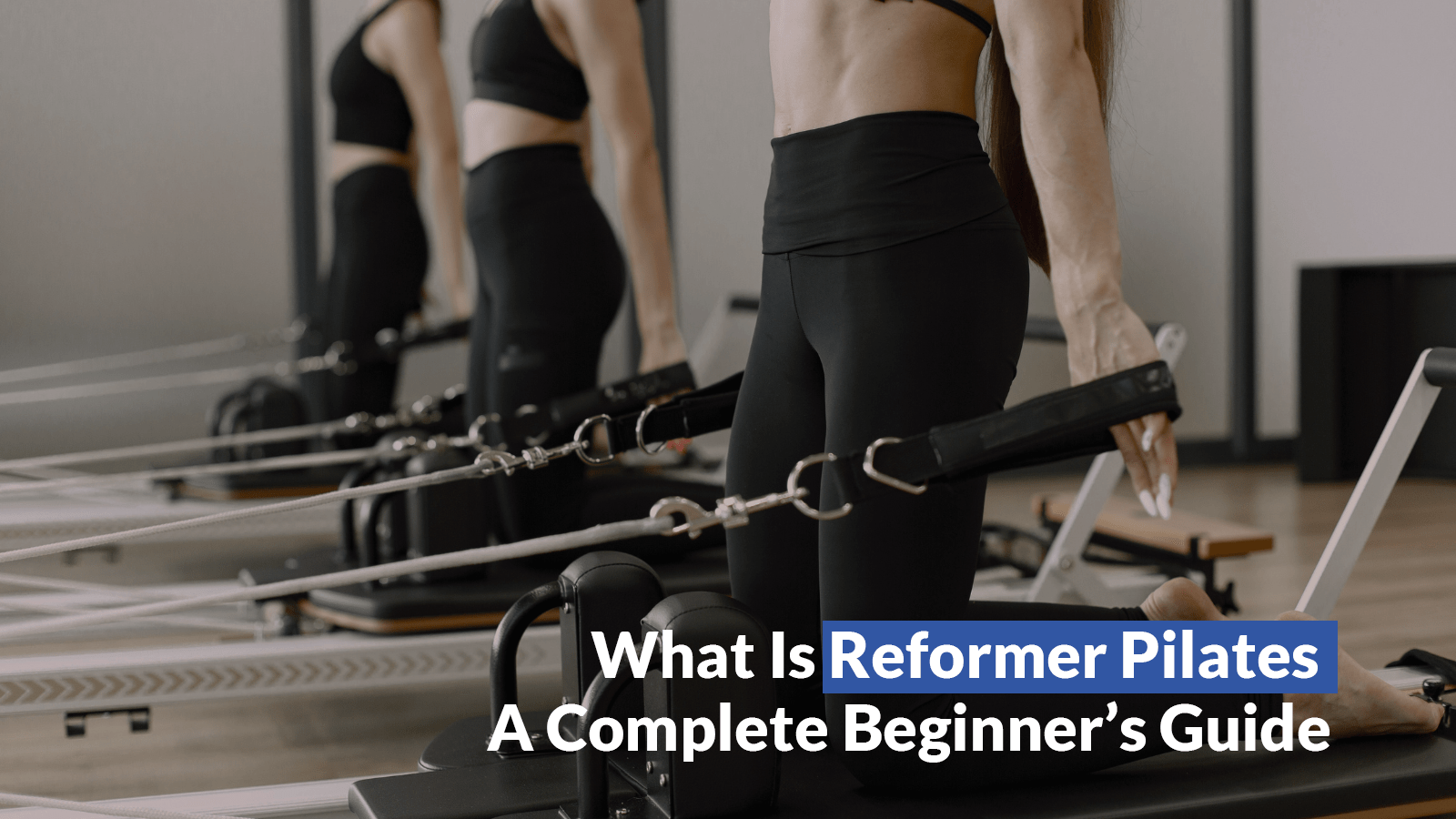Reformer Pilates is a contemporary twist to traditional Pilates that uses special gear to make it a uniquely challenging workout. It’s becoming popular globally because it’s an awesome way to get fit, feel calm, and experience the concrete advantages that extend beyond general fitness.
Get this – Reformer Pilates actively contributes to reducing back pain, enhancing mood, and managing BMI effectively.
Curious to give it a crack or just find out more before signing up? Read this complete beginner’s guide that covers everything you need to know about Reformer Pilates.
From explaining the mechanics of the reformer machine to outlining the distinct benefits of Reformer Pilates and how to join a Reformer Pilates class near you, we’ve defined it all here. We’ve got all your queries answered and explained if you’re new to Pilates and fascinated by the transformative potential of the reformer version.
So, take a look if you want to know more about one of the best workouts going around!
What is Reformer Pilates?
Reformer Pilates utilises a specialised apparatus known as a “reformer.” This reformer has a sliding carriage that moves back and forth along a fixed frame. The carriage connects by ropes and pulleys to resistance springs that you can adjust to make the exercises harder or easier depending on your fitness level.
There are also straps, handles, bars, and other bits and pieces on the reformer to let you get into different positions to perform the Pilates moves. As you push or pull the sliding carriage against the resistance of the springs, it works and tones all areas of your body – legs, bum, back, arms, and core.
Unlike mat Pilates, the reformer provides stability and resistance that helps isolate muscle groups, improve alignment, challenge your balance, and take classic Pilates moves to the next level. The spring system allows for exercises at various difficulty levels, making Reformer Pilates suitable for any age or fitness level.
You might be amazed to learn that Fitness Reformer Pilates is a favourite workout of some celebrities, like Jennifer Aniston, Meghan Markle, and Kate Hudson.
It’s a great way for an incredibly efficient full-body workout. A well-balanced reformer routine helps make all your muscles stronger, keeps your joints flexible, makes your core (tummy and back) strong, and also makes your heart beat faster.
Top 5 Benefits of Reformer Pilates
Reformer Pilates offers a truckload of health and fitness benefits for both your body and mind. No wonder it’s becoming so popular! Here are just some of the top reasons people are getting into Reformer Pilates classes:
1. Strengthened Muscles
Reformer Pilates provides resistance and works on the big muscles in your legs, arms, back, shoulders, and bum. This helps make your muscles stronger and gives them a good shape.
2. Increased Flexibility
The reformer carriage in Pilates acts as a dynamic platform for targeted stretching exercises, facilitating extensive movement. This specialised equipment focuses on improving joint mobility and flexibility through precise techniques such as hamstring stretches, hip openers, and spinal extensions. The result is not just increased flexibility but a significant improvement in overall joint function and mobility. Engaging in these practised movements not only makes daily activities more effortless but also remarkably reduces the risk of injury by promoting a greater range of motion.
3. Better Posture and Alignment
With a focus on precise, controlled motions, Reformer Pilates teaches body awareness and good alignment habits. The practice involves precise cues for maintaining proper posture throughout exercises, resulting in a direct transfer of these improvements to daily life. As individuals engage in Reformer Pilates, the shoulders naturally relax downward, the spine elongates, and overall balance sees a notable enhancement. This leads to a concrete and enduring benefit of not just improved posture during workouts but a sustained refinement of daily posture, fostering long-term musculoskeletal health and well-being.
4. Accelerated Fat Burning
The muscle toning and cardiovascular benefits of Reformer Pilates lead to accelerating fat burning and facilitating potential weight loss. The reformer machine accommodates individuals across all fitness levels, from beginners to advanced students, to engage in higher-intensity workouts, a feat not always possible on a conventional mat. More calories are burnt during these fast-paced sequences.
The dynamic nature of Reformer Pilates, especially during fast-paced sequences, results in a heightened calorie burn. This not only contributes to efficient fat metabolism but also offers a pathway to achieving weight loss goals, making it an effective and rewarding fitness choice.
5. Elevated Mood and Lower Stress
Endorphins released during physical activity improve mood and reduce anxiety. Reformer Pilates demands deep concentration and breathwork, achieving a “flow state” for the mind-body connection. Students finish classes feeling calm, happy, and accomplished.
Along with greater core strength and stability, Reformer Pilates delivers total body balance. Muscles strengthen uniformly on both sides to prevent imbalances or injury over time. Control, coordination, and confidence also progress thanks to focused core work.
What to Expect in a Reformer Pilates Class
In beginner Reformer Pilates classes, the instructor will first teach you proper and safe form on the reformer machine and equipment. You’ll learn basic foundational Pilates exercises and movements on the apparatus. The teacher will guide you through any modifications you need to work at your own pace and ability.
More advanced Reformer Pilates classes may include faster-paced cardio sequences or dynamic exercises that flow from one position to the next.
Reformer Pilates classes generally follow a predictable, well-rounded format to give students a full-body workout along with relaxation:
Warm Up Stretches
Usually done on the mat, gentle stretches prepare muscles and increase blood flow. Common stretches include hamstring and calf stretches, spinal twists, hip openers, and shoulder rolls.
Main Reformer Exercises Sequence
This makes up the bulk of class time. The coach guides you through a sequenced series of Pilates Reformer exercises targeting all important muscle groups. You can make the exercises harder or easier by using springs and your weight. You can do them lying down, sitting, kneeling, or standing on the sliding carriage. Exercises work on various body parts like legs, glutes, abs, arms, shoulders, chest, and back.
Cooldown Stretches
The last 5-10 minutes are spent gently stretching muscles worked during the session. This allows students to progressively relax the body and calm the mind after an intense workout. It’s an important part of injury prevention as well.
A full Reformer Pilates class lasts about 45-60 minutes in total. It’s a low-impact yet highly effective Pilates workout structured to strengthen the entire body while also decompressing the mind. Students often feel energized yet centred after a good reformer class.
Proper breathing technique is heavily emphasized during reformer classes to get the most mind-body benefits. You’ll get verbal and visual cues from the instructor on inhaling and exhaling in rhythm with certain Pilates moves. Over time, the breathing patterns become second nature.
How to Stay Safe on the Reformer
While the name sounds intense, Reformer Pilates is not scary when practised carefully! However, it does require close attention to your instructor and deliberate controlled movements, especially for beginners first getting accustomed to the reformer machine. Follow these key safety guidelines in Reformer Pilates classes:
Wait for Instructor Cues
Listen for verbal guidance and watch demonstrations before adjusting springs or moving the carriage. Never pull ropes, straps, or push the carriage without being properly set up first. This prevents risky uncontrolled motions.
Maintain Control
Move slowly and steadily as you push and pull the sliding carriage. Avoid using momentum or speed through movements. Control the carriage through the full range of motion in both directions. This minimises the risk of strain or injury.
Watch Your Joints
Pay attention to joint positions during exercises. Never overstretch or force joints beyond a comfortable range of motion. Modify exercises as needed to keep joints protected. Listen to any discomfort signals from your body.
Proper Alignment
Always keep a neutral spine by engaging core muscles. The pelvis should be level, the rib cage lifted, and the shoulders back. Proper postural alignment reduces unwanted strain on the joints and muscles during exercise.
Know Your Limits
Work at an intensity that feels challenging but not painful. Fatigue is normal, pain is not. Immediately stop and notify the instructor if an exercise causes any sharp, radiating or intense pain. Don’t push through pain or discomfort.
The apparatus takes some getting used to. Take it slow in the beginning by using lighter resistance springs. Ask for modifications or help from the teacher at any time. Be patient with yourself as you build coordination on the reformer equipment through regular Pilates classes.
Soon you’ll find a rhythm to moving the carriage and springs. Over time, expect to feel greater overall core strength, muscle control, and confidence during reformer exercises. Pay attention to your instructor, breathe deeply, and have fun discovering all the unique benefits Reformer Pilates offers!
Ready to Try Reformer Pilates? Find a Reformer Pilates Class Near You!
Convinced that Reformer Pilates can transform your fitness routine and overall wellness? Now comes the next important step!
Search online directories for highly rated Reformer Pilates classes close to your location. Many offer new client specials like discounted 5- or 10-class packs for $100-150, making it very affordable to try. Private sessions are also available if you want one-on-one instruction when first starting out.
Reformer Pilates requires specialised equipment like the carriage, ropes, and pulleys and certified instructors, so be wary of cheap deals that seem too good to be true. Investing in a quality studio with experienced teachers is the key to mastering proper technique and seeing all the incredible benefits of Reformer Pilates like improved posture, flexibility, and core strength.
Soon you’ll be reaping all the rewards that Reformer Pilates has to offer! Commit to regular practice 2-3 times per week and prepare to feel stronger in body and calmer in spirit. Incorporating Reformer Pilates into your self-care routine can be truly transformative over time! Consider this your personal invitation to initiate your healthcare journey with Osteopath Sydney.


